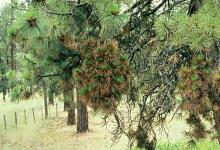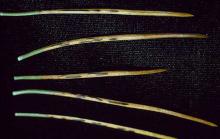Cause The fungus Elytroderma deformans is a serious needle cast of ponderosa and Jeffrey pine. Hosts also include Coulter, knobcone, lodgepole, and pinyon pine. Spores disperse in spring or early summer, infecting current-season needles. After infecting, the fungus can become systemic, growing through the needle into twigs where it can survive unfavorable conditions. It is most damaging along creeks and lakeshores or in drainages with moist environmental conditions.
Symptoms Needles stay green 1 year after infection, turning red the next spring. Witches' brooms form several years later. Infected twigs have brown necrotic flecks in the inner bark. Needles on these twigs are infected during formation. The narrow, elongate, black fruiting bodies (hysterothecia) form on all surfaces of dead needles and are visible on 2-year-old infected, red needles.
Can easily be confused with other needle cast diseases. Needle cast diseases are identified by microscopically examining fruiting bodies and spores. Needle casts can also be confused with annual (normal) fall needle drop. Most conifers shed some of their oldest needles in the fall. These old needles often turn yellow or brown before falling off.
Cultural control
- Avoid planting in low-lying areas with poor air drainage.
- Space plants for good air circulation.
- Forest trees-thinning stands is helpful.
- Control weeds and vegetation around the bases of trees.
- For high-value trees, prune off and destroy witches' brooms.
Reference Hansen, E. and Lewis, K.J. 1997. Compendium of Conifer Diseases. St. Paul, MN: APS Press.



